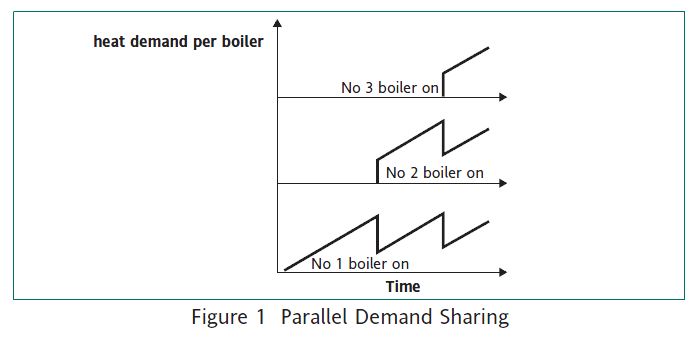Você precisa de ajuda para escolher o produto certo?
Nossa ferramenta irá combinar o melhor produto para suas necessidades
Iniciar selecionador de produtosBem-vindo ao site da Brazil
Detectamos que você pode preferir o site United Kingdom. Por favor, use o menu de idiomas acima para alterar sua opção se necessário.
One of the primary goals in operating a boiler plant is to ensure that the working steam pressure (or temperature in hot water systems) is sustainable for any load demand placed on the plant. At the same time, this requirement must be met as efficiently and cost effectively as possible. In a multi-boiler plant, this can be achieved through the implementation of demand load management, the purpose of which is to distribute the steam demand in an optimised manner and to adjust the boiler plant output to meet working requirements. This ensures that boilers are fired only when required, thus reducing running costs. Alternatively, demand load management can allow each boiler to be allocated the same amount of running time. The Eurotherm application module for demand load management offers a comprehensive set of functions, some of which are described below.
Operator load allocation
The demand share arrangement allows each boiler to be operated in either base-load or modulating service, finding the best distribution of load between the boilers that will result in the lowest overall cost.
The base-load operation leaves the implementation up to the operator. In this mode, the total demand is shared between the baseload boilers in proportion to the operator set base-load values. The modulating mode of operation, on the other hand, enforces automatically the load allocation without the need for operator intervention. The total demand, less that satisfied by the base-load boilers, is shared between the modulating boilers in proportion to their capacities. The flexibility of the control module is such that one combination of boiler modes can be applied dynamically to the boiler plant.
Demand sharing
In boiler plants, the most effective load allocation is not based on a simple operating decision but on real-time calculations taking into account the following
A further important decision involves the demand sharing methodology, which can be either parallel or series, depending on plant requirements. The Eurotherm control module allows for both configurations.
In parallel, the available boilers share the total demand simultaneously by taking up an equal firing rate to meet the load. On load increase, the firing rate of all modulating boilers will increase equally until the load requires an additional boiler. At this point, the firing rate of the active boilers decreases to compensate for the firing rate of the newly started boiler. Figure 1 explains the process for an increase of load.
Parallel modulation is generally implemented for steam boilers. It offers the most effective control when relatively steady process loads are available. As the system modulates the boiler plant to adjust the common header pressure to the required setpoint, a smoother response to changing load conditions is performed by the controller.

Series demand sharing allocates loads by normally forcing one boiler at a time to modulate in order to satisfy the demand and is most effective when used with the Eurotherm demand schedule control module. On load increase, the firing rate of the modulating boiler will increase until the load requires an additional boiler. At this point, a new boiler is started and becomes the modulating boiler. The other active boilers are ramped to their optimum firing rate. Figure 2 explains the process for an increase of load.
Series modulation is generally implemented for hot water systems or fluctuating steam loads. This mode allows faster individual boiler response to plant conditions as the boiler pressure is adjusted to the required setpoint.
The boilers that are chosen to always run are referred to as the ‘lead’ boilers. All the other boilers are ‘lag’ boilers but are prioritised such that a boiler with a high priority always runs before a boiler with a low priority and so on. E.g. the most effective boiler is always started first and the least effective one is always stopped first.

Boiler banking
This functionality is achieved by keeping the available boilers in hot standby mode until required to fire. This is achieved by ntermittently firing the unused boilers, thus maintaining a required pressure by use of upper and lower banking thresholds or by recirculation of return water through the boilers to keep them hot. The main advantage of boiler banking is that it acts a ‘warm’ start facility improving the plant response to sudden load changes.
8-day timer
Further enhancement to the man machine interface is achieved by the 8-day timer facility depicted in Table 1. Boiler banking is tabulated according to daily upper and lower banking threshold pressures with an additional user definable ‘Today’ schedule to be loaded if and when required. Up to four optional session settings can be preconfigured and stored at the supervisory computer.
Multi-sequence programme selection In order to meet the plant demand with savings on fuel consumption, the boiler dispatching can be automated via a multi-sequence programme selection. The boiler duties can then be scheduled according to configurable daily sessions or sequences of events. The effects of this feature are
Demand load management is an optimising function that augments, but does not replace, the combustion control system.

Selecionador de produtos
Nossa ferramenta irá combinar o melhor produto para suas necessidades
Iniciar selecionador de produtosContete-Nos